USS John F. Kennedy (CV-67)
 USS John F. Kennedy is escorted out of NS Mayport, Florida by tugboats, on 11 November 2003.
| |
| Class overview | |
|---|---|
| Name | John F. Kennedy class |
| Builders | Newport News Shipbuilding |
| Operators | |
| Preceded by | Template:Sclass- and Template:Sclass- |
| Succeeded by | Template:Sclass- |
| In commission | 7 September 1968 – 1 August 2007 |
| History | |
| Name | USS John F. Kennedy |
| Namesake | John F. Kennedy |
| Awarded | 30 April 1964[1] |
| Builder | Newport News Shipbuilding[1] |
| Laid down | 22 October 1964[1] |
| Launched | 27 May 1967[1] |
| Sponsored by | Caroline Kennedy[2] |
| Christened | 27 May 1967 |
| Commissioned | 7 September 1968[1] |
| Decommissioned | 23 March 2007[1] |
| Refit | 1984 |
| Stricken | 16 October 2009[1] |
| Motto |
|
| Nickname(s) | "Big John" (unofficially: "Bldg 67") |
| Fate | Museum ship |
| Status | On Donation Hold for use as a museum and memorial[1] |
| Badge |  |
| General characteristics | |
| Type | Aircraft carrier[3] |
| Displacement |
|
| Length | 1,052 ft (321 m) overall, 990 ft (300 m) waterline |
| Beam | 252 ft (77 m) extreme, 130 ft (40 m) waterline |
| Height | 192 ft (59 m) from top of the mast to the waterline |
| Draft | 36 ft (11 m) maximum, 37 ft (11 m) limit |
| Installed power |
|
| Propulsion |
|
| Speed | 34 knots (63 km/h; 39 mph) |
| Capacity | 5,000+ |
| Complement | 3,297 officers and men (without jet commands & crews) |
| Armament |
|
| Aircraft carried | 80+ |
USS John F. Kennedy (CV-67) (formerly CVA-67) is the only ship of her class (a variant of the Kitty Hawk class of aircraft carrier) and the last conventionally powered carrier built for the United States Navy.[3] The ship is named after the 35th President of the United States, John F. Kennedy, and is nicknamed "Big John." Kennedy was originally designated a CVA (fixed wing attack carrier); however, the designation was changed to CV to denote that the ship was capable of anti-submarine warfare, making her an all-purpose carrier.
After nearly 40 years of service in the United States Navy, Kennedy was officially decommissioned on 1 August 2007. She is berthed at the NAVSEA Inactive Ships On-site Maintenance facility in Philadelphia. She is available for donation as a museum and memorial to a qualified organization.[1][4] The name has been adopted by the future Gerald R. Ford-class aircraft carrier John F. Kennedy (CVN-79).
Ship history

Design & early years
Contracted as Ship Characteristic Board SCB-127C,[5] the ship's keel was laid on 22 October 1964 by Newport News Shipbuilding. The ship was officially christened 27 May 1967 by Jacqueline Kennedy and her 9-year-old daughter, Caroline, two days short of what would have been President Kennedy's 50th birthday. The ship entered service 7 September 1968.
John F. Kennedy is a modified version of the earlier Template:Sclass-s.[6] Originally scheduled to be the fourth Kitty Hawk-class carrier, the ship received so many modifications during construction she formed her own class.[3] The ship was originally ordered as a nuclear carrier, using the A3W reactor, but converted to conventional propulsion after construction had begun.[5] The island is somewhat different from that of the Kitty Hawk class, with angled funnels to direct smoke and gases away from the flight deck. Kennedy is also 17 feet (5.2 m) shorter than the Kitty Hawk class.[5]
After an ORI conducted by Commander, Carrier Division Two, Kennedy left for the Mediterranean in April 1969. The ship reached Rota, Spain on the morning of 22 April 1969 and relieved USS Forrestal. Rear Admiral Pierre N. Charbonnet, Commander, Carrier Striking Forces, Sixth Fleet, and Commander, Carrier Striking Unit 60.1.9, shifted his flag to John F. Kennedy. The turnover complete by nightfall, the carrier, escorted by destroyers, transited the Strait of Gibraltar at the start of the mid watch on 22 April. The next day, John F. Kennedy refueled from USS Marias, and acquired the company of a Soviet Template:Sclass2- (Pennant No. 383).
1970s
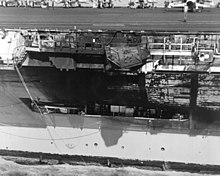
Kennedy's maiden voyage, and several of her subsequent voyages, were on deployments to the Mediterranean during much of the 1970s to help deal with the steadily deteriorating situation in the Middle East. It was during the 1970s that Kennedy was upgraded to handle the F-14 Tomcat and the S-3 Viking.
Kennedy was involved in the Navy response to the Yom Kippur War in the Middle East in October 1973, with her actions and the larger U.S. Navy picture being described in Elmo Zumwalt's book On Watch.[7]
In 1974, she won the Marjorie Sterrett Battleship Fund Award for the Atlantic Fleet.
On 20 June 1975 Kennedy was the target of arson, suffering eight fires, with no injuries, while at port in Norfolk, Virginia.[8]
On 22 November 1975 Kennedy collided with the cruiser Belknap, severely damaging the smaller ship and earning itself the nicknames "Can Opener" and "Jack the Tin Can Killer." As a result of the collision with John F. Kennedy's overhanging deck, JP-5 fuel lines were ruptured spraying fuel over an adjacent catwalk, and fires ensued aboard both ships. Belknap's superstructure was gutted almost to the main deck, and seven of her crew killed. Aboard Kennedy, smoke inhalation claimed the life of Petty Officer 2nd Class Yeoman David A. Chivalette of CVW-1.
On 14 September 1976, while conducting a nighttime underway replenishment 100 miles (160 km) north of Scotland, the destroyer Bordelon lost control and collided with Kennedy, resulting in such severe damage to the destroyer that she was removed from service in 1977. Earlier the same day, one F-14 Tomcat, following a problem with the catapult, fell off of the flight deck of John F. Kennedy, with AIM-54 Phoenix missiles in international waters, off the coast Scotland. Both crew members ejected and landed on the deck, injured but alive.[9] A naval race (surface and submarine) followed between the Soviet Navy and US Navy to get back not only the plane (because of its weapon system), but also its missiles.
In late 1978 Kennedy underwent her first, yearlong overhaul, which was completed in 1979.
On 9 April 1979 she experienced five fires set by arson while undergoing overhaul at Norfolk Naval Shipyard, Virginia. The fires killed one shipyard worker and injured 34 others.[8]
On 5 June 1979 Kennedy was the target of two more fires at Norfolk Naval Shipyard, Virginia. No one was injured in the incident.[8]
In 1979 she won her second Marjorie Sterrett Battleship Fund Award.
1980s

In 1982 the ship sailed on her ninth deployment, and her first visit to the Indian Ocean after transiting the Suez Canal. During this tour Kennedy played host to the first visit of the Somali head of state.
In October 1983 John F. Kennedy was diverted to Beirut, Lebanon from her planned Indian Ocean deployment, after the Beirut barracks bombing killed 241 US military personnel taking part in the Multinational Force in Lebanon, and spent the rest of that year and early 1984 patrolling the region. On 4 December 1983 ten A-6 aircraft from Kennedy along with A-6 and A-7 aircraft from USS Independence took part in a bombing raid over Beirut, in response to two US F-14 aircraft being fired upon the previous day. The Navy lost two aircraft during the raid: an A-7E from Independence and an A-6E from John F. Kennedy were shot down by SAMs. The A-7E pilot was picked up by a fishing boat, but the A-6E pilot Lt. Mark Lange died after ejecting and the B/N Lt. Robert "Bobby" Goodman was taken prisoner and released on 3 January 1984.[6]
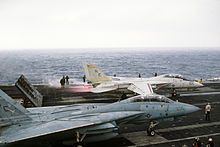
In 1984 the ship was drydocked at the Norfolk Naval Shipyard for a one-and-a-half year complex overhaul and upgrades.
In 1985 Kennedy received the initial awarding of the Department of Defense Phoenix Award for Maintenance Excellence for having the best maintenance department in the entire Department of Defense.[10]
Setting sail in July 1986, Kennedy participated in the International Naval Review to help mark the Re-dedication of the Statue of Liberty. Kennedy served as the flagship for the armada before departing on her eleventh overseas deployment to the Mediterranean in August – highlighted by multiple Freedom of Navigation exercises in the Libya's Gulf of Sidra, and operations off of the coast of Lebanon as a response to increasing terrorist activities and U.S. citizens being taken hostage in Beirut. The ship returned to Norfolk, Virginia in March 1987.
In August 1988 Kennedy departed on her twelfth overseas deployment. During this deployment, a pair of MiG-23 Flogger fighter aircraft from Libya approached the carrier task force, which was 81 miles (130 km) off the shore of Libya near the declared Libyan territorial waters of the Gulf of Sidra. Kennedy launched two F-14 Tomcats from VF-32 "Fighting Swordsmen" to intercept the incoming MiGs. The U.S. planes were sent to escort the MiGs away from the task force. During the course of the intercept, the MiGs were determined to be hostile and both of the Libyan aircraft were shot down.
1990s
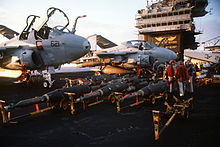
Kennedy returned to the U.S. in time to participate in Fleet Week in New York and Independence Day celebrations in Boston, Massachusetts before receiving an "All-hands" recall on 28 July 1990, for Operation Desert Shield. The ship was empty of fuel, and ordnance and equipment as it was ready to join the yards for some SRA maintenance. Once the Warning order was issued, the ship went into 24 hour supplies replenishment procedures. She took on all the supplies and equipment she had just been offloading. She took on additional fuel and ordnance while crossing the Atlantic Ocean. She departed the United States combat ready faster than any ship had accomplished since the Vietnam War. She departed on 10 August 1990, and became the flagship for the commander of the Red Sea Battle Force. At midnight on 17 January 1991 Kennedy's Carrier Air Wing 3 commenced the very first strike operations against Iraqi forces as part of Operation Desert Storm. Between the commencement of the operation and the cease-fire, Kennedy launched 114 airstrikes and nearly 2,900 sorties against Iraq, which delivered over 3.5 million pounds of ordnance. On 27 February 1991 President George H. W. Bush declared a cease-fire in Iraq, and ordered all U.S. forces to stand down. Kennedy was relieved, and began the long journey home by transiting the Suez Canal. She arrived in Norfolk on 28 March 1991.
While at Norfolk the ship was placed on a four-month selective restricted-availability period as shipyard workers carried out maintenance. Extensive repairs to the flight deck, maintenance and engineering systems were made. Additionally, the ship was refitted to handle the new F/A-18C/D Hornet.
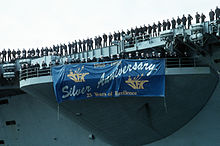
With the upgrades completed, John F. Kennedy departed on her 14th deployment to the Mediterranean, assisting several task forces with workup exercises in anticipation of intervention in Yugoslavia. When Kennedy returned she was sent to the Philadelphia Naval Shipyard, where she underwent a two-year extensive overhaul. Upon completion of the overhaul the ship was transferred to the Mayport Naval Station near Jacksonville, Florida, which remained the ship's home port.
On 1 October 1995, John F. Kennedy was designated an operational reserve carrier and reserve force ship assigned to the U.S. Atlantic Fleet. She would be available to deploy with either an active or reserve air wing when mobilized in support of urgent operational requirements. John F. Kennedy's new primary function would be to provide a surge capability, and in peacetime, to support training requirements. She would participate in routine fleet exercises, aviator carrier qualifications, and battle group training.[11]
JFK made a high-profile visit to Dublin, Ireland during an Atlantic deployment in 1996. Here, more than 10,000 people were invited to tour the ship at anchor in Dublin Bay. The visit was also intended to honor two personalities who had made a great impact on history: John F. Kennedy, for whom the ship was named, and Commodore John Barry, a native of County Wexford, Ireland who played an instrumental role in the early years of the United States Navy. Officers and crew from Kennedy joined local military and civilian organizations in celebrating Barry's achievements at his statue in Crescent Quay, Wexford, and three F-14 Tomcat fighters flew at low level over the town. Jean Kennedy Smith, sister of John F. Kennedy, was the U.S. ambassador to Ireland at the time, and was among those who welcomed the ship to Ireland.
During her visit to Ireland, high winds in Dublin Bay caused the boarding pontoon to tear a large hole in JFK's hull.
Kennedy's 15th Mediterranean deployment included two transits of the Suez Canal, and four months deployed in the Persian Gulf. One night in the Gulf two Iranian F-14's were flying low altitude at high speed heading toward the ship. The AEGIS cruiser Vicksburg acquired the jets on radar and warned them to turn away, which they did. She returned in time to participate in Fleet Week '98 in New York City.
During Kennedy's 16th deployment, she became involved in a rescue mission when the tug Gulf Majesty foundered during Hurricane Floyd in mid-September 1999. The ship successfully rescued the crew of the vessel, then headed toward the Middle East, where she became the first U.S. aircraft carrier to make a port call in Al Aqabah, Jordan, in the process playing host to the King of Jordan, before taking up station in support of Operation Southern Watch.
John F. Kennedy was the only conventionally powered U.S. carrier underway at the end of 1999, arriving back at Mayport on 19 March 2000. After a brief period of maintenance (Advanced combat direction system was installed), the carrier sailed north to participate in 4 July International Naval Review, then headed to Boston for Sail Boston 2000.
2000s

During Kennedy's last round of refits the ship became a testbed for an experimental system for the Cooperative Engagement Capability, a system that allowed Kennedy to engage targets beyond original range.
In 2001, during a pre-deployment trial, Kennedy was found to be severely deficient in some respects, especially those relating to air group operations; most problematic, two aircraft catapults and three aircraft elevators were non-functional during inspection, and two boilers would not light. As a result, her captain and two department heads were relieved for cause.
As the 11 September attacks of 2001 unfolded, John F. Kennedy and her battle group were ordered to support Operation Noble Eagle, establishing air security along the mid-Atlantic seaboard, including Washington, D.C. JFK was released from Noble Eagle on 14 September 2001.[6]
During the first six months of 2002, Kennedy aircraft dropped 31,000 tons of ordnance on Taliban and al Qaeda targets in support of Operation Enduring Freedom.[6]

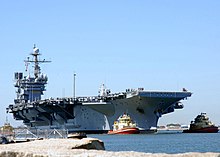
In July 2004 Kennedy collided with a dhow in the Persian Gulf, leaving no survivors on the traditional Arab sailing boat.[12] After the incident the Navy relieved the commanding officer of Kennedy. The carrier itself was unscathed, but two jet fighters on the deck were damaged when an F-14B Tomcat assigned to VF-103 slid into an F/A-18C Hornet assigned to VFA-81 damaging the wing of the F-14 as well as the upper section of the radome and forward windscreen of the F/A-18 as the ship made a hard turn to avoid the tiny vessel. A popular misconception is that the Kennedy captain waited to make the turn at the last possible moment to recover aircraft critically low on fuel returning from airstrikes. The official review board determined this was not the case and the aircraft could have remained safely aloft until Kennedy maneuvered to avoid the dhow.[13]


Kennedy was the most costly carrier in the fleet to maintain and was due for an expensive overhaul; budget cutbacks and changing naval tactics prompted the U.S. Navy to decide to retire her.[14] On 1 April 2005 the Navy formally announced that the carrier's scheduled 15-month overhaul had been cancelled.[15]
Before decommissioning she made a number of port calls to allow the public to "say farewell" to her, including a stop at her "homeport" Boston Harbor.[16] John F. Kennedy also took part in the 2005 New York City Fleet Week festivities at the Intrepid Sea-Air-Space Museum.[17] She was decommissioned in Mayport, Florida on 23 March 2007.[18]
The ship's unique in-port cabin, which was decorated by Jacqueline Kennedy with wood paneling, oil paintings, and rare artifacts, was disassembled, to be rebuilt at the National Museum of Naval Aviation at Naval Air Station Pensacola, Florida.[19]
John F. Kennedy was towed to Norfolk, Virginia on 26 July 2007. She remained in Norfolk until a shoaled area near Pier 4 in Philadelphia could be dredged to enable the ship to safely dock. On 17 March 2008 at about 1700, she was seen leaving Norfolk Naval Station under tow of the tug Atlantic Salvor. On 22 March 2008 Kennedy arrived, with the afternoon high tide, at the Naval Inactive Ship Maintenance Facility in Philadelphia.[20] She is currently laid up in the Philadelphia reserve fleet .[21]
Future plans
In November 2009, the Navy placed Kennedy on donation hold for use as a museum and memorial.[22] A report in the Boston Herald newspaper on 26 November 2009 mentioned the possibility of bringing Kennedy to the Boston, Massachusetts area, as a museum or memorial at no cost to the city, if desired.[23]
In August 2010, two groups successfully passed into Phase II of the U.S. Navy Ship Donation Program:[24]
- Rhode Island Aviation Hall of Fame,[25] Providence, Rhode Island
- USS John F. Kennedy Museum,[26] Portland, Maine
On 19 January 2011 the Portland, Maine City Council voted 9–0 to not continue with the project to bring the ship to Maine.[27]
Current plans as of September 2014 have the Rhode Island Aviation Hall of Fame working to secure Pier 2 of the Naval Station Newport. These developments come after the former USS Saratoga (CV-60) was sold for scrapping earlier in the year after years of being moored in Newport.[28][29]
With the advent of the nuclear carrier, Kitty Hawk and John F. Kennedy are the last two candidate carriers to become museum ships as they have conventional propulsion. Nuclear carriers, such as Enterprise and the Template:Sclass-, require extensive deconstruction to remove their nuclear reactors during decommissioning, leaving them in an unsuitable condition for donation.[30]
Call sign
| International radio call sign of USS John F. Kennedy (CV-67)[24] | |||
| November | Juliet | Foxtrot | Kilo |
In popular culture
- The TV series Supercarrier was partially filmed on board the ship between September and November 1987, while the ship was undergoing a period of upkeep.[31]
References
- ^ a b c d e f g h i "John F. Kennedy". Naval Vessel Register. Retrieved 9 December 2010.
- ^ "John F". Dictionary of American Naval Fighting Ships. Navy Department, Naval History and Heritage Command. Retrieved 9 December 2010.
- ^ a b c Navy Announces Availability of ex-John F. Kennedy for Donation
- ^ SEA 21 Navy Inactive Ships Program Feb. 3, 2010
- ^ a b c Friedman, Norman (1983). U.S. Aircraft Carriers: An Illustrated Design History. Naval Institute Press. p. 387. ISBN 0-87021-739-9. Retrieved 18 December 2008.
- ^ a b c d "John F Kennedy". History. US Navy.
- ^ Zumwalt, 'On Watch,' 1976, 436–448
- ^ Popular Mechanics, June 1977, Volume 147, #6
- ^ United States Department of Defense, Secretary of Defense Maintenance Awards
- ^ "John F. Kennedy". DANFS.
- ^ "Persian Gulf Maritime Mishap". navy.mil. 23 July 2004. Retrieved 24 October 2009.
- ^ "USS John F. Kennedy Commanding Officer Relieved". navy.mil. 26 August 2004. Retrieved 31 October 2009.
- ^ Jack Kelly (3 April 2005). "Carrier's fate launches political battle". The Pittsburgh Post-Gazette. Retrieved 31 October 2009.
- ^ "No Overhaul for USS John F. Kennedy". globalsecurity.org. Navy News Stand. 1 April 2005. Retrieved 31 October 2009.
- ^ Raphaella Zerey (5 March 2007). "Thousands pay last visit to USS JFK". The Daily Free Press. Archived from the original on 21 January 2009. Retrieved 21 January 2009.
- ^ [1]. City Guide For Fleet Week 2005
- ^ Mark D. Faram (26 March 2007). "After storied career, JFK's saga finally ends". Navy Times. Retrieved 31 October 2009.
- ^ Henry J. Holcomb (22 March 2008). "Aircraft carrier John F. Kennedy scheduled to arrive in Philadelphia today". The Philadelphia Inquirer. Archived from the original on 8 April 2008. Retrieved 31 October 2009.
- ^ Matthew Jones (19 March 2008). "Deactivated carrier JFK on its way to Philadelphia storage yard". The Virginian-Pilot. Retrieved 19 March 2008.
- ^ http://peoships.crane.navy.mil/Inactiveships/Donation/inactiveships_news.asp
- ^ Edward Mason (26 November 2009). "Hub floated as possible home for JFK warship". The Boston Herald. Retrieved 26 November 2009.
- ^ Rhode Island Aviation Hall of Fame's USS John F. Kennedy Aircraft Carrier Project
- ^ USS John F. Kennedy Museum, Portland, Maine
- ^ PressHerald.com: Proposed Carrier Site Voted Down, January 20, 2011.
- ^ "Goodbye, Sara". Providence Journal. 31 August 2014. Retrieved 11 October 2014.
- ^ Lennon, Frank (20 September 2014). "Frank Lennon: JFK carrier could be big boon for R.I." Providence Journal. Retrieved 11 October 2014.
- ^ http://www.military.com/daily-news/2012/10/22/enterprise-nimitz-class-carriers-wont-be-museums.html
- ^ "John F. Kennedy (CVA-67)". Naval History and Heritage Command. 23 July 2015. Retrieved 28 July 2015.
External links
- USS John F. Kennedy webpage Unofficial
- Maritimequest USS John F. Kennedy CV-67 Photo Gallery
- USS John F. Kennedy page at globalsecurity.org
- USS John F. Kennedy history at U.S. Carriers
- The short film Home From The Sea (1970) is available for free viewing and download at the Internet Archive.
- USS John F. Kennedy Project
